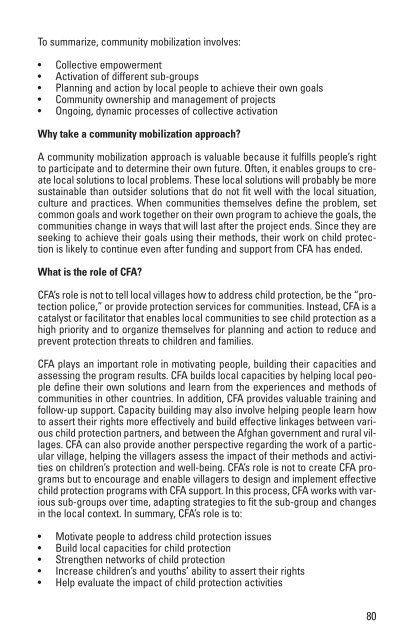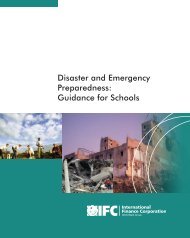Starting Up Child Centered Spaces in Emergencies: A Field Manual
Starting Up Child Centered Spaces in Emergencies: A Field Manual
Starting Up Child Centered Spaces in Emergencies: A Field Manual
- No tags were found...
You also want an ePaper? Increase the reach of your titles
YUMPU automatically turns print PDFs into web optimized ePapers that Google loves.
To summarize, community mobilization <strong>in</strong>volves:• Collective empowerment• Activation of different sub-groups• Plann<strong>in</strong>g and action by local people to achieve their own goals• Community ownership and management of projects• Ongo<strong>in</strong>g, dynamic processes of collective activationWhy take a community mobilization approach?A community mobilization approach is valuable because it fulfills people’s rightto participate and to determ<strong>in</strong>e their own future. Often, it enables groups to createlocal solutions to local problems. These local solutions will probably be moresusta<strong>in</strong>able than outsider solutions that do not fit well with the local situation,culture and practices. When communities themselves def<strong>in</strong>e the problem, setcommon goals and work together on their own program to achieve the goals, thecommunities change <strong>in</strong> ways that will last after the project ends. S<strong>in</strong>ce they areseek<strong>in</strong>g to achieve their goals us<strong>in</strong>g their methods, their work on child protectionis likely to cont<strong>in</strong>ue even after fund<strong>in</strong>g and support from CFA has ended.What is the role of CFA?CFA’s role is not to tell local villages how to address child protection, be the “protectionpolice,” or provide protection services for communities. Instead, CFA is acatalyst or facilitator that enables local communities to see child protection as ahigh priority and to organize themselves for plann<strong>in</strong>g and action to reduce andprevent protection threats to children and families.CFA plays an important role <strong>in</strong> motivat<strong>in</strong>g people, build<strong>in</strong>g their capacities andassess<strong>in</strong>g the program results. CFA builds local capacities by help<strong>in</strong>g local peopledef<strong>in</strong>e their own solutions and learn from the experiences and methods ofcommunities <strong>in</strong> other countries. In addition, CFA provides valuable tra<strong>in</strong><strong>in</strong>g andfollow-up support. Capacity build<strong>in</strong>g may also <strong>in</strong>volve help<strong>in</strong>g people learn howto assert their rights more effectively and build effective l<strong>in</strong>kages between variouschild protection partners, and between the Afghan government and rural villages.CFA can also provide another perspective regard<strong>in</strong>g the work of a particularvillage, help<strong>in</strong>g the villagers assess the impact of their methods and activitieson children’s protection and well-be<strong>in</strong>g. CFA’s role is not to create CFA programsbut to encourage and enable villagers to design and implement effectivechild protection programs with CFA support. In this process, CFA works with varioussub-groups over time, adapt<strong>in</strong>g strategies to fit the sub-group and changes<strong>in</strong> the local context. In summary, CFA’s role is to:• Motivate people to address child protection issues• Build local capacities for child protection• Strengthen networks of child protection• Increase children’s and youths’ ability to assert their rights• Help evaluate the impact of child protection activities80
















